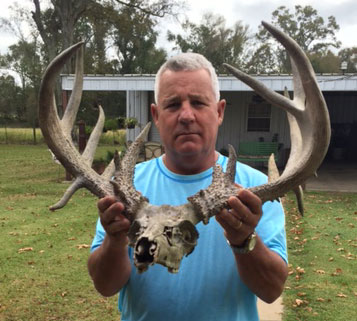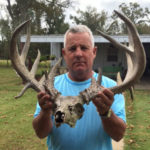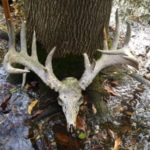
Huge 17-point buck probably died late in 2014 or early 2015, biologist says
Just a few days before Thanksgiving, Justin Chatelain and his son Jarred wrapped up a relatively uneventful morning hunt on Grand Lake Rod and Gun Club in eastern Avoyelles Parish.
The two men had been hunting about 150 yards apart, and Justin wanted to show his son a brand new stand he had put up earlier this year on their way out of the woods.
“It was a stand he had never seen before, and it was in the direction our bikes were parked,” said the elder Chatelain, 63, of Marksville. “So we just took a little minor detour. It wasn’t but about 40 yards from my stand.”
What they found literally left both men speechless — and has created quite a stir at the almost 8,000-acre hunting club.
They stumbled across a truly amazing set of antlers that Louisiana Department of Wildlife and Fisheries Deer Study Leader Johnathan Bordelon scored at a whopping 189 ⅜ inches Boone and Crockett. (Bordelon’s gross score for the non-typical buck was 199 6/8 inches.)
“The first thing I said was, ‘Oh my God,” Justin Chatelain said. “I couldn’t believe it. We just kept staring at it. Then he held it, and I held it. And I couldn’t wait to get back to the camps.
“That’s the biggest set of horns I’ve ever seen, especially out of Grand Lake. There have been some beautiful deer killed, but as far as I know that’s the biggest that’s ever come out of there. Nobody killed it, but still — it was on Grand Lake property.”
Chatelain, who’s hunted the property in Area 6 since the early 70s and joined the club in 1987, said other members were just as flabbergasted by the amazing 17-point, heavy-horned rack.
“Most of them said, ‘Where did you find that?’ I said, ’On Grand Lake.’ They said, ‘Nah, there’s no way.’
“We just normally don’t see deer like that on Grand Lake. We have nice deer, but we don’t have deer with drop tines. This one had two.”
The circumference at the rack’s bases was just under 7 inches, but heavy mass carried all the way to the tips.
“Of the four measurements on each main beam, the smallest one was right at 7 inches. One of the largest in the palmated area was over 8,” he said. “It carried mass all the way to the end.”
Bordelon couldn’t estimate the buck’s age because its lower jaw was missing, but guessed it died somewhere between October of 2014 and February of this year.
“It was in the center of the club off a ridge, in an area that was logged six or seven years ago that hadn’t grown back up,” Chatelain said. “There wasn’t a lot of trees around it. That’s why it was so bleached out — I guess the sun hit it.”
Chatelain didn’t take the time to look for any other bones from the animal, but plans to return to the area soon to see what he can find. Remarkably, the rack remained in almost pristine condition.
“There wasn’t but one or two very tiny spots on it where the squirrels had nibbled on the horns,” he said. “He (Bordelon) couldn’t get over that. He said the squirrels normally eat them up and there’s very little left.
“That’s why he’s thinking it’s no more than a year old.”
No other club member has told Chatelain they had shot at the buck, or even seen it on trail cams. Bordelon said it was quite possible the old buck just died of natural causes.
“He said if they have any infection coming out of the rut, sometimes they can’t make it,” Chatelain said. “With the rut and an infection, their bodies can’t take it and they just die a natural death.”
Chatelain suspects the big buck probably came over from the Lake Ophelia National Wildlife Reserve, which borders the club to the west.
“At Ophelia, they have bucks with drop tines,” he said. “That’s why we’re thinking he might have jumped the fence, probably chasing does, and ended up on us.
“Most of the huge bucks that are killed on Grand Lake, we think they’re coming from the Lake Ophelia area.”
His taxidermist is bleaching the skull, but leaving the antlers natural, and Chatelain plans on hanging the massive rack up at his camp.
“I got a wall for it,” he said with a grin.
He’s hopeful the big buck bred with some Grand Lake does and passed its genetics down into their herd, but even if he never gets the chance to shoot a deer that big, he’s thankful for just finding the antlers — two days before Thanksgiving.
“I’d have loved to seen it, and would have loved to have shot it and killed it, but I told Jarred, ‘This is a one in a million finding it.’ I can’t imagine what it would have been like shooting it,” Chatelain said. “But just putting my hands on a Boone and Crockett is thrill enough for me.”




